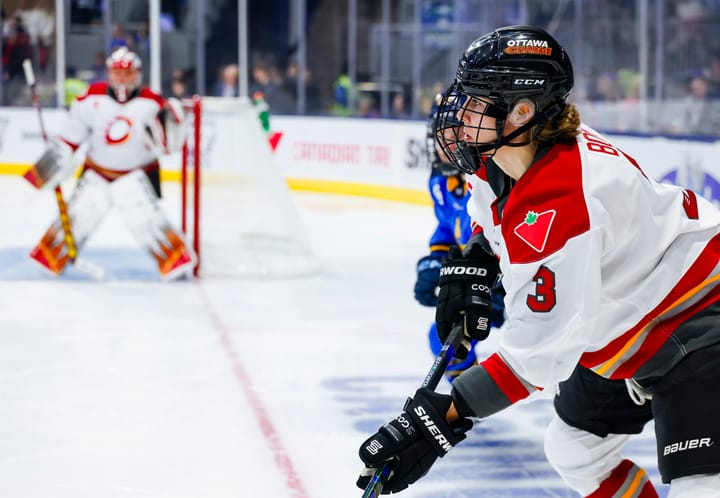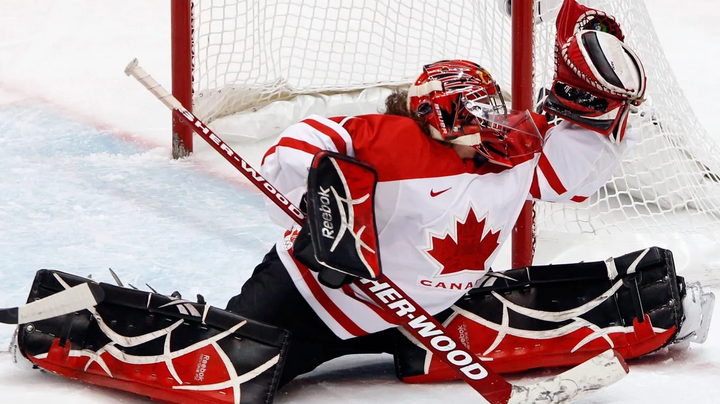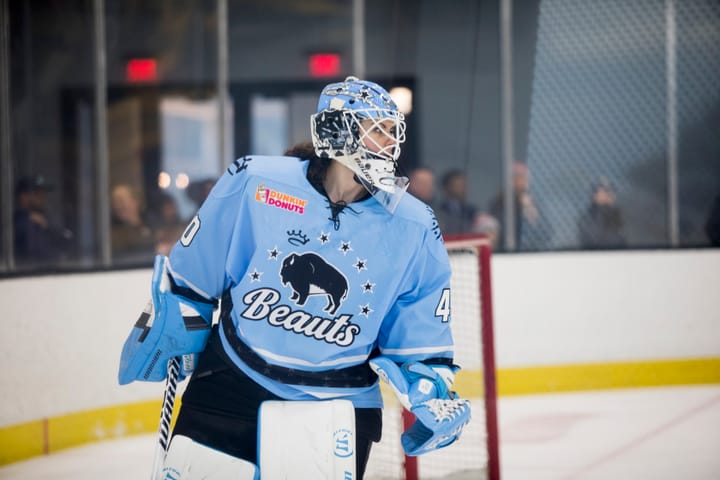Q&A with Hayley Moore on her career in hockey
The NWHL Deputy Commissioner and Director of Girls Hockey at the East Coast Wizards discusses her management role in hockey
Working in the front office of two different hockey leagues wasn’t exactly what Hayley Moore had in mind while she was playing hockey.
Moore played at Brown University for four seasons, with her final two as the captain. She had 133 points in 123 games and two seasons where she scored 20 or more goals. Following the NCAA, she played in Switzerland and in the CWHL’s inaugural season for the Boston Blades. She notched 14 points in 26 games with the Blades that year, all the while trying to find her next move in hockey.
This led the Massachusetts-native behind the bench first as an assistant coach at UMass-Boston in 2010-11, then to a prep school as a head coach and athletic director before she landed behind the bench at Harvard University as an assistant coach from 2012-14. Moore was the first general manager of the NWHL’s Boston Pride for the league’s first season in 2015-16, which included her lacing up her skates for her team on Dec. 15, 2015.
Now she’s the NWHL Deputy Commissioner and the Director of Girls Hockey at the East Coast Wizards, an elite hockey program based in Bedford, Mass.
The Ice Garden recently spoke with Moore about her life in hockey off the ice.
The Ice Garden: So, you have two different roles. You are the Deputy Commissioner of the NWHL and also with the East Coast Wizards. Can you talk about what you do with the Wizards?
Hayley Moore: This my fifth season with the Wizards, and I’m the Director of Girls Hockey. That means a variety of different things, but one of the big reasons that I was attracted to the position is because it is a management role and not just coaching role.
I do enjoy coaching, but my passion is kind of working to develop the game, provide resources to players, manage people — really just kind of grow the game on a bigger level. I think that’s where my strengths lie and where my passion is. I am lucky enough to have found my home here with the Wizards and to have been able to grow out of a college coaching role to this management role.
I oversee the girls side of our program, which consists of 23 teams from learn-to-play through U19. I really have the opportunity to work with players at every single level of the game, which is really rewarding and really helps kind of round out my experience.
I hire coaches and influence the curriculum that we establish here. We host tournaments, showcase events. I help players through the prep school process, and moving on from that, I help players and parents navigate the recruiting process for the NCAA and collegiate levels, trying to help them kind of get to the next level. I’m able to to kind of see these players through the whole stepping stones in their career. Then, conversely with the NWHL, I can help college players move on in their career and enter the professional realm. It’s cool for me to kind of see both sides of it.
I am on the ice almost every single day. I tell my players that I’m on the ice with, they’re my saving grace.
It’s a pretty all-inclusive management role. I would say as a director here, I’m kind of wearing many hats. I’ll work in skills sessions with every age level. I do coach a full season with a U19 teams. I have those players on the ice every day and am helping them through the college recruiting process. It’s pretty all-encompassing, but it’s a very rewarding space to me because I kind of have my hand in all levels of the game.
TIG: What were the stepping stones that you took to be able to get to that position? How did you gear up for a role like that in your post-playing days or even during your playing days?
HM: As a player, I never really thought about working in hockey outside of playing hockey, if that makes sense. I was a biology major in college, and I was so focused on playing the game that I loved for so long that when it came to an end, it kind of happened quickly.
I really saw myself moving away from the game as a whole as a career. I didn’t see opportunities outside of coaching. I thought that I could only find the love of the game by playing it. I found out really quickly that I was wrong.
I started keeping an open perspective to anything. I was at a point where I was trying to figure out what my career was going to be, what I was going to be passionate about, on top of my full-time career in medical device consulting, which was my first big job out of college.
I started picking up some stuff on the side that I was really passionate about. I knew that I needed to be open-minded and to try everything out in order to figure out what my path was going to be. I started volunteering, taking on different coaching roles because that was the way for me to figure out if I wanted to stay involved in the game. While that hasn’t necessarily been the path for me, it did kind of help me [get] exposed to the business of hockey and the career of working in hockey outside of playing.
I just started saying yes to everything. It was never an easy path. I think what made me so grateful to be where I’m at now is that I kind of went through the stages of learning. I worked in a prep school and as an athletic director. I found that I really liked kind of working on that side of athletics. It just kind of took a little bit of time for me to put the pieces of the puzzle together, and then end up where I am now.
I’m really happy that I’m really fortunate to be a woman in hockey in a management position. It’s very rare, but I think that the more we continue to drive the sport forward the more opportunities there are going to be for women to work outside of coaching. And I think that it’s a really special place to be.
TIG: Do you see the NWHL and the CWHL as good stepping stones for women to have post-collegiate opportunities off the ice as well?
HM: Absolutely. I am so grateful for the league for providing that to me. I think that it’s given me the opportunity to really find what I excel at. Until our leagues existed, I don’t think I would have had that opportunity as much as I do now.
With the CWHL and NWHL existing, it’s just providing a platform for women to work in professional sports and to not have to work in professional sports for a men’s program. They can work in the sport that they have loved their entire life.
For so long, people would ask me, “So what’s next for you? Like do you want to work for an NHL team? Do you want to work in marketing?” And that was kind of the old school mentality of any woman that wants to work in sports is gonna go work for a professional men’s team. I take pride in the fact that that’s not necessarily what I want my path to be. I want there to be opportunity for women in women’s sports and I’m really proud that that’s what I get to represent right now.
TIG: What’s a typical work day for you like?
HM: A typical day is different every day. But I guess that’s what makes it unique and what keeps me on my toes. I like to think that I’m a pretty organized person and that’s kind of what gets me through the day-to-day. Typically I have everything very scheduled, from the moment I wake up to the moment I go to sleep. I have my days very planned out. I think that’s kind of just what keeps me on track, whether it’s a Wizard focus for the first half of the day to an NWHL focus on the second half of the day or everything being intertwined.
I am on the ice almost every single day. I tell my players that I’m on the ice with, they’re my saving grace. At times, they’re my one hour to get on the ice and to remember how much I love the game and to just take a deep breath. It gives me a little bit of clarity, and that hour away from the phone or the computer that I can use to recalibrate and then I’m ready to rock and get back at it.
I try to never let myself get too far behind. Every day is a workday. I would much rather kind of keep up with things and allow myself to take an hour here or there every day from myself then to completely shut off for a day and feel like I’m getting behind. I just kind of roll with the punches, try to stay really organized, and enter each day with a pretty organized plan. I am a big to-do list person.
TIG: A couple of quick rapid fire questions: When you were playing, who was your favorite teammate?
HM: I feel like all of my friends will be mad if I don’t say them. I’d have to say my best friend, Stacy Silverman. I grew up playing hockey with her. She’s a goalie. We played club hockey from U12 all the way up together, at Cushing in high school for four years together and at Brown together as well. I joke that she’s the reason I learned how to score goals. She would drag me to all of her goalie clinics and make me like shoot in the same spot over and over again. She’s definitely my favorite teammate.
TIG: Who was your hardest opponent?
HM: Player or team?
TIG: Both.
HM: OK. I think I’d have to say Gigi Marvin as a player. We played against each other in college and when Minnesota scores in their rink, [fans have] obnoxious chants where they spell out Minnesota. And I can still hear the announcers say “Giiiiii Giiii Marrrrrrvin.” Like oh my gosh would she stop scoring on us please. So, I think I’ll pick Minnesota as the toughest opponent then, too. We played against them two out of my four years of college. We did not end up on the winning side. For in-conference rival, it was always Harvard.
Sarah Vaillancourt is a player I faced so often in our Cushing/Pomfret and Brown/Harvard high school and college rivalries. She was the most frequent and dangerous player I ever faced, so lethal every time she was on the ice! She was so good that even when she scored against you it was hard not to admire it and her skill on the spot.
TIG: Dream linemates? It can be from any era, current past.
HM: Who wouldn’t want to play with Cammi Granato? She’s certainly on the list. And, I’m going to go with another one from her era: Sandra Whyte. She’s a local here [Massachusetts] and somebody that I looked up to.
TIG: Favorite on-ice moment of your entire career?
HM: In 2008, I was able to go to the NCAA skills competition, which was in Denver. I don’t think they still do the events anymore. It wasnvery cool; they did it for a few years where they would bring in players from every team to represent their conferences and have a skills competition during the men’s Frozen Four. So 2008, I was able to go to that in Denver. It was a really cool experience being out there with players from all over the NCAA Men’s and Women’s as it was a combined men’s and women’s skills competition.
TIG: Favorite moment from your post-playing hockey career?
HM: I’d have to say winning the Isobel Cup with the Pride in Season 1.





Comments ()